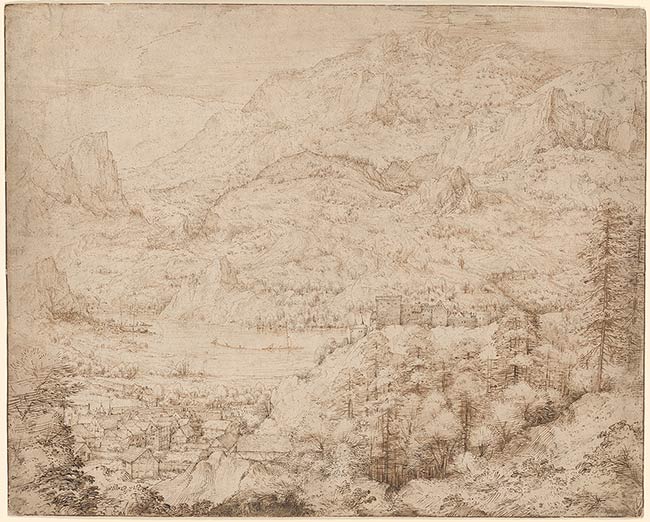

Watermark: Fleur-de-lis in shield, surmounted by crown, with letter "W" below (Strasbourg Lily), (similar to Briquet 7210 and Piccard 1297-1350).
This majestic drawing, which dramatically evokes the grandeur of the Alpine landscape, was until recently given to Pieter Bruegel the Elder (ca. 1525-1569) and considered the most accomplished of a group of mountain landscapes thought to have been executed by him after a sojourn through the Alps. In 1991 Hans Mielke argued that the drawing should be removed from Bruegel's oeuvre because its watermark has been associated with papers not documented before the mid-1580s (Hans Mielke, 'Pieter Bruegel d. ⁴.: Probleme seines zeichnerischen Oeuvres,' "Jahrbuch der Berliner Museen", n.s., 33 [1991], pp. 129-34). He argued further that stylistically the drawing was closely comparable to sheets he suggested had been copied from, not made in the preparation of, the etchings known as The Large Landscapes (Hans Mielke, 'Noch Einmal zum Problem von Pieter Bruegels Landschaftszeichnungen', "Muenchner Jahrbuch der bildenden Kunst" 3. F. 42 [1991], pp. 137-147; Hans Mielke, "Pieter Bruegel: Die Zeichnungen", [Turnhout], 1996, no. A 1). The etchings were made after drawings by Bruegel thought to have been executed during his trip through the Alps (Nadine M. Orenstein, ed., "Pieter Bruegel the Elder: Drawings and Prints", exh. cat., New Haven and London, 2001, pp. 120-21).
Mielke tentatively ascribed these drawings, including the Morgan sheet, to Roelandt Savery (1576-1639). The Morgan drawing is of the type likely made by Bruegel as elaborate presentation pieces for collectors in the Lowlands, souvenirs of his Alpine journey, composed in the studio shortly after his return to Antwerp in about 1555 (Felice Stampfle, "Netherlandish Drawings of the Fifteenth and Sixteenth Centuries and Flemish Drawings of the Seventeenth and Eighteenth Centuries in the Pierpont Morgan Library", New York and Princeton, 1991, p. 26). They are probably the works to which Karel van Mander referred when he commented that "[Bruegel] swallowed all those mountains and rocks, and on returning home, spewed them out on canvases and panels, so realistically was he able to follow nature..." (Schilder-boeck, [1603-]1604, fol. 233; cited in Martin Royalton-Kisch, "The Light of Nature: Landscape Drawings and Watercolours by Van Dyck and his Contemporaries, exh. cat., London, 1999, p. 45). Examples of the type include two sheets by Bruegel in the British Museum, Mountain Landscape with a River and Travelers (inv. O.0.9-9 [P.2]; Orenstein 2001, no. 9, repr.) and Landscape with Fortified City (inv. 1909-4-6-1[P.1]; Orenstein 2001, no. 10, repr.). Such drawings constitute some of the earliest surviving landscapes by a Northern artist and are thought to have been composed from sketches, now lost, that Bruegel made on site (Orenstein 2001, pp. 120-21). Mielke's argument in favor of Roelandt Savery as possibly the author of the Morgan sheet is compelling. Comparing the Library's drawing to four sheets in the Courtauld Institute Galleries, London, which Mielke gave to "Roelandt Savery?" (Mielke 1996, nos. A4, A5, A6, and A12, repr.), one finds close comparisons in the shaggy pine trees with drooping boughs, in the jagged outlines of the mountains and the edges of the clouds, in the parallel hatching in the clouds and directly above the summits, in the use of a few dots and hatchings near the summits to define the most distant mountains, and in the use of darker ink to suggest the passage between planes.
Other possible attributions of the Morgan drawing have recently been advanced. Martin Royalton-Kisch ('Review of "Pieter Bruegel. Die Zeichnungen" by Hans Mielke', "The Burlington Magazine" 140 [1998], p. 208 n.3) has proposed Roelandt's elder brother Jacob Savery (ca. 1565-1603) as the author of the Morgan drawing because of the similar pen work in the foreground of the sheet and that of a drawing Mielke reassigned from Bruegel to Jacob Savery, Rocky Landscape in the Akademie der bildenden Kuenste, Vienna (Mielke 1996, no. A21; in correspondence with the author [May 15, 2005], Royalton-Kisch affirmed the opinion he expressed in the 1998 review). Indeed, the foregrounds of both drawings exhibit remarkably similar jagged pen lines, although the rest of the drawings are quite dissimilar, a point conceded by Royalton-Kisch, who nonetheless says that Jacob Savery "appears to have been more chameleon-like than his younger brother Roelandt" (Royalton-Kisch 1998, p. 208 n.3). Most recently Nadine Orenstein (2001, no. 120), finding neither Savery a satisfactory suggestion, has proposed an anonymous artist she calls the Master of the Mountain Landscapes as the author of the Morgan drawing. The question of authorship of the Morgan drawing is further complicated by the watermark whose identification prompted Mielke's rethinking of Bruegel's oeuvre. The watermark literature shows the mid-1580s as its first documented use, not proof of when the paper was actually created. Furthermore, of Mielke's group of twenty reattributed drawings, only the Morgan sheet and one other-Broad Mountain Range in the Staatliche Kunstsammlungen, Dresden-bear this watermark; the remaining eighteen either have no watermark or are lined to a thick backing that prevents a possible watermark from being discerned (Orenstein 2001, p. 267 n.3). --Kathleen Stuart
Inscribed at lower right in brown ink, "P. BR . . .V . . . L", partly effaced.
Carwardine, Thomas, 1735-1824, former owner.
Probert, Thomas, Mrs., former owner.
Probert, W. J., former owner.
Probert, Geoffrey, former owner.
Probert, Oliver, former owner.
Stampfle, Felice, with the assistance of Ruth S. Kraemer and Jane Shoaf Turner. Netherlandish Drawings of the Fifteenth and Sixteenth Centuries and Flemish Drawings of the Seventeenth and Eighteenth Centuries in the Pierpont Morgan Library. New York : Pierpont Morgan Library, 1991, p. 24, no. 43.
Dervaux, Isabelle. Drawing connections: Baselitz, Kelly, Penone, Rockburne, and the old masters. New York: Morgan Library & Museum, 2007, p. 31-32 (repr.)
